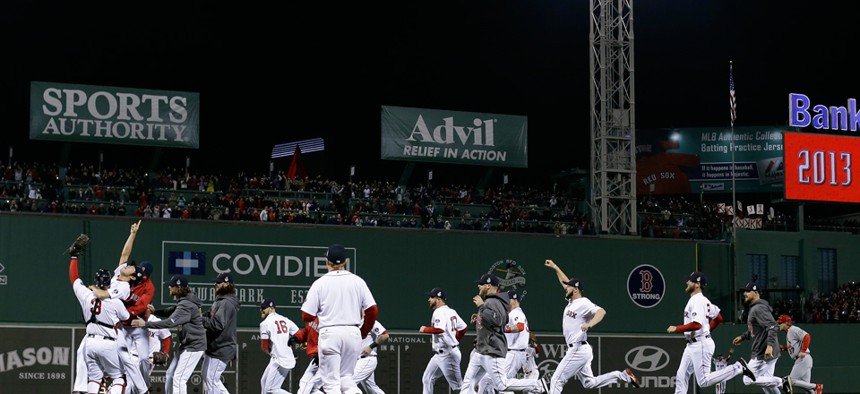Why Public Executives Need Both Talent and the Elusive Team Chemistry
Even your top players are only as the group’s best effort.
On Aug. 25, 2011, the Boston Red Sox had won 80 games and lost only 50. If the team could maintain that winning percentage of .615, it would finish the season with 100 wins and make the playoffs.
Instead the Red Sox collapsed, losing 22 of its last 32 games. The team’s three top pitchers, it was later reported, spent most games not in the dugout but in the clubhouse eating takeout chicken and drinking beer. Terry Francona, the manager with whom the team had won the 2004 and 2007 World Series, was fired.
In 2012, the Boston Red Sox were worse. They won 69 games, but lost 93—for a winning percentage of .426. The team hadn’t had such a poor record since 1960, when they won only .422 of their games. That was before any of today’s baseball players were even born.
In 2013, however, the Red Sox won the World Series. “Worst to First” goes the cliché.
What factor made the difference? Or, to be precise, what factors made the difference? After all, there is never a single cause. And there were many.
Quickly, Boston fired its manager, the incendiary Bobby Valentine. His “managerial style,” wrote one blogger, was “obnoxious pomposity.” The Sox replaced him with the ever calm, always positive John Farrell.
Actually, during the 2012 season, the Sox had already made big changes. Boston traded three of its big salary stars whom it had acquired precisely because of their excellent statistics but who never got what Yogi Berra called “the team thing.”
In Boston, this was not unusual. The 1989 Sox were known as “25 guys and 25 cabs.” Steven Renko, a pitcher, explained: “Some teams go everywhere together. We get off the plane and go to 25 separate cabs.”
Thus, on opening day in 2013, few fans in Boston knew the new players. They were familiar with Mike Napoli and Shane Victorino. But Jonny Gomes? Mike Carp? Ryan Dempster? David Ross? Fans couldn’t even pronounce Koji Uehara. None were superstars. They were “character guys.”
Being a good clubhouse guy was not, however, the No. 1 criterion. Talent was. The new players had to be able to play major league baseball. But they also had to be able to play in a major league city.
In Boston, the Bruins, the Celtics, the Patriots, and the Red Sox are serious business—everybody’s business. When a hitter takes a called third strike in the bottom of the ninth, the citizens of Red Sox Nation will offer advice—very personal, very public advice.
When John Henry, who then owned the Florida Marlins, bought the Boston Red Sox, he discovered that people recognized him on the street. That never happened in Miami.
Boston is different. In Miami, no one cares. In Boston, everyone cares.
Thus, the Red Sox sought to combine team talent with team chemistry. “It has to start with talent,” said Ben Cherington, the team’s general manager. But he was also “trying to get as many guys on the team that would embrace playing in Boston.”
And they did—individually and collectively. They grew beards, and their motto became “Fear the Beards.” And after the bombing at the finish line of the Boston Marathon, the team became one of the symbols of “Boston Strong”—from the first game after the city’s lockdown to the victory parade.
Yet, not everyone believes in team chemistry. As the 2013 season began, Boston’s most read sports columnist, Dan Shaughnessy, argued that “chemistry in a baseball clubhouse is way overrated.”
Yet if chemistry is overrated, talent is overrated too. If only talent counted, the 2012 Red Sox would never have finished in last place.
Still, what is this team chemistry? How does it work? And, even more importantly, how do you create it?
After all, the sabermetricians have yet to develop a formula to measure it, although Michael Schrage of MIT writes that “quantifying chemistry” has become “the new Holy Grail of sports analytics.”
But are these data wonks seeking to measure a team’s “teamness” or how one player improves the performance of the others? Then, once a team has such data, how do they use it to achieve their objectives?
Five years ago, Michael Lewis, the author of Moneyball (about the use of data in baseball), wrote an article about “The No-Stats All-Star.” That would be Shane Battier, who in 13 years and nearly 1,000 games for four NBA teams has averaged 8.6 points per game. What player lasts 13 years while averaging less than 10 points?
Lewis explains: “Battier’s game is a weird combination of obvious weaknesses and nearly invisible strengths. When he is on the court, his teammates get better, often a lot better, and his opponents get worse—often a lot worse.”
Shane Battier is the ultimate team player. He creates the elusive team chemistry. Yet no team or player has figured out how to replicate him.
Robert D. Behn, a lecturer at Harvard University's John F. Kennedy School of Government, chairs the executive education program Driving Government Performance: Leadership Strategies that Produce Results. His book, The PerformanceStat Potential, will be published by Brookings in June.
Copyright 2014 Robert D. Behn



